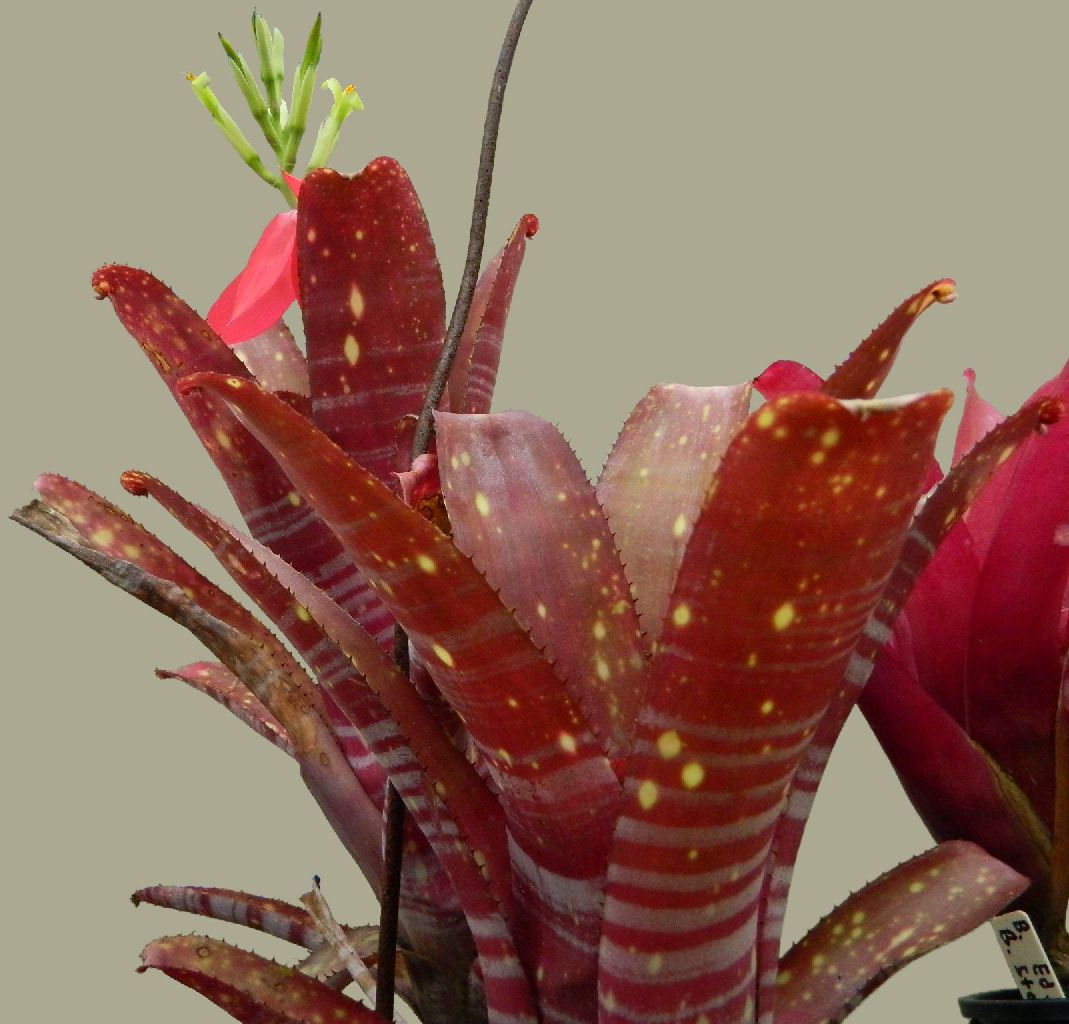

This brings us to Billbergia amoena with 9 varieties and the problems we have had in Australia starting in the 1960’s. Remember that at this time the only Monograph available was Mez 1935. I will show the key.
Petala virentia non nisi summo apice minuta violaceo-maculata.
- Folia (praesertim in vivo manifeste) dorso ad vaginae apicem impressa.
- Sepala apice minute mucronulata rubra nec maculate rubra nec maculate variegata
- Sepala flavo-virentia apice indigotino-maculata nec mucronulata Wiotiana
- Folia dorso ad vaginae apicem haud impressa.
- Folia lata abbreviataque, interiora apice late emarginata; inflorescentia nutans vel pendula
- Foliorum spinulae validae; bracteae cum sepalis acutiusculis speciosa
- Foliorum spinulae minimae; bracteae roseae, sepala virentia rotundata amoena
- Folia angustiora elongatioraque, interiora apice haud emarginata vero mucrone herbaceo imposito rotundata; inflorescentia erecta.
- Folia glabra.
- - Folia ad 0,75 m longa - pallescens
- - Folia vix ultra 0,25 m longa. - Wacketii
- - Folia dense lepidotula. - pallida
I leave it to you to translate from the Latin, but from the species names you will recognise ‘amoena’. It shows how one botanist saw different species! A key is not the be-all, end-all of the matter because you still have to check the description! When Smith & Downs was published in 1979 these species became varieties of B. amoena
l. Leaves green.
2. Sepals green except for the dark blue apex
3. Petal blades dark blue at apex, elsewhere green. - 3a. var amoena
3. Petal-blades wholly green. - 3b. var viridis
2. Sepals red toward apex. - 3c. var minor
l. Leaves red. - 3d. var rubra
Over the years more varieties were added by Brazilian botanists and in 1994 Fontoura showed that there was no difference between var. rubra and the type so this became var amoena. Finally in 2012 I found it necessary to resurrect var. cylindracea which had been hiding as a possible synonym under B. sanderiana.
So at the moment my key is
Key to Varieties of Billbergia amoena as at 2012.
1. Ovary smooth - var robertiana
1a. Ovary sulcate -> 2
2. Leaves 8-20 in a subellipsoid rosette -> 3
2a Leaves 5 forming a tube - var cylindracea
3. Stolons long -> 4
3a. Stolons short -> 5
4. Petals green with blue tips - var. stolonifera
4a Petals wholly green - var. stolonifera forma viridiflora
5. Sepals green except for dark blue apex -> 6
5a.Sepals green but red toward the apex - var. minor
5b Sepals red at base - var. carnea
6. Petal blades wholly green - var. viridis
6a Petal blades not wholly green -> 7
7. Petals dark blue at apex - var. amoena
7a. Petals yellow at apex - var. flavescens
That covers the situation from the botanists' point of view although there is a twist because while Foster who collected var viridis says that petals and sepals are wholly green, Smith’s description says that sepals are tipped blue!
What has happened in Australia? I think we are growing the varieties amoena, carnea, stolonifera and viridis. There is a plant with red leaves and greenish spots and some silver bands with B. amoena var rubra on the label but has the flower of var. viridis not var. amoena. One such owner, Kent Jacobsson tells us that he got his plant from Peter A Franklin but with the comment on the label ‘Could be a hybrid!’ We know it is not PAF 799 nor PAF 1005 because of the petal colour! Now, Peter comes from Raymond Terrace which is near Newcastle which is Bill Morris’s stamping ground and alarm bells started ringing. You see, in the 1980’s the Butchers got a plant from Bill with B. amoena rubra x viridis on the label and we never got round to naming this intraspecific cross. In those days this was not technically a hybrid being intra-species. How different was it? Did it show attributes from both parents? All we know is that Bill got his plant of B. amoena var viridis from Kent’s nursery in California. From Bill’s memory this was a green plant with broad trichome banded leaves (not mentioned in the botanical description) and a flower that had total green petals and sepals. Offsets of this plant may still be in some Aussie collections. It is also reasonable to assume that the intraspecific cross (with probable white bands) that Bill Morris created is also around and could well be the plant to which we refer. Because of the uncertain identification of Kent Jacobsson’s plant I maintain we should follow Geoff Lawn’s suggestion and call it ‘Beaut Ruby’ and register it.
If there are other growers out there having a plant called Billbergia amoena var rubra and it looks like the plant featured here please change its name to ‘Beaut Ruby’!
Billbergia Beaut Ruby
amoena (rubra) x amoena var. viridis ?
From Geoff Lawn ... "Mature, tubular, vase-shaped rosette to 40cms. high. Bronze / brick red leaves with cream spotting and silver cross-banding on the reverse. Erect spike to 50cms. tall with rose-pink scape bracts, green sepals tipped blue and green petals tipped blue. Thought to be synonymous with the former B. amoena var. rubra, which in 1994 was reclassified as B. amoena var. amoena. To retain this distinctive cultivar's identity, it was decided to name and register it as B. 'Beaut Ruby'. Reg. Doc. 10/2014